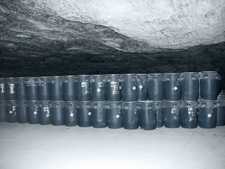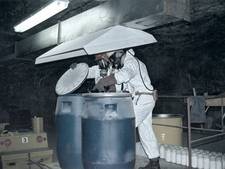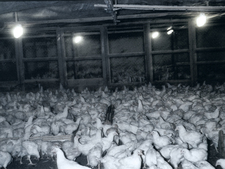1958 - 1996: Chicken production and interim storage of toxic waste in the GDR
- In the former GDR chicken were produced in the Marie mine, while the repository we know today was being constructed in the Bartensleben mine. Later on toxic waste was stored intermediately in the Marie mine.
- From 1971, low-level and intermediate-level radioactive wastes were disposed of in the Bartensleben mine. Small amounts of radioactive waste were stored intermediately.
Chicken production in the Marie mine
In 1958, on their 5th party conference, the SED decided to increase the production of consumer goods. Within seven years, the chicken production was to increase by 700 per cent. Former chambers in the Marie mine where armament had been produced were fit out for chicken farming.
Until 1984 the mine was used for chicken production. During this period about 15,000 tons of poultry were produced. Part of the waste water accrued remained underground. Slaughterhouse operation stopped in 1990.
Interim storage of toxic waste in the Marie mine

![]() Drums containing toxic wastes stored intermediately
Drums containing toxic wastes stored intermediately
In 1985, the GDR Council of Ministers decided to temporarily store drums filled with cyanide-containing hardening salts in the Marie mine. Parts of the toxic wastes had already been stored in two boiler rooms in Beendorf under conditions that were harmful to the environment.

![]() Examination of a drum prior to relocation
Examination of a drum prior to relocation
No experience was available on underground storage. The waste producers therefore had to carry out tests on the storage behaviour. Safety concerns relating to the radioactive waste repository were assessed. From 1987, following trial phases, the wastes were then stored in chambers that had served as storage facilities in National Socialism. The 20,000 drums were relocated by 1996.
Repository for radioactive waste in the Bartensleben mine
Parallel to chicken production and interim storage of toxic waste in the Marie mine, the former GDR used the Bartensleben mine as a repository for radioactive wastes. Solid and liquid radioactive wastes were disposed of. Furthermore, radioactive wastes were stored intermediately. The general public in the GDR was badly informed.
| Year | Event |
|---|---|
| 1959 - 1984 | Chicken production in the Marie mine |
| Until 1969 | Mining of rock salt in the Bartensleben mine |
| From 1971 | Disposal of radioactive wastes in the Bartensleben mine |
| 1987 - 1996 | Interim storage of toxic hardening salts in the Marie mine, 1995 – 1996 retrieval of the wastes |
State of 2017.01.03


